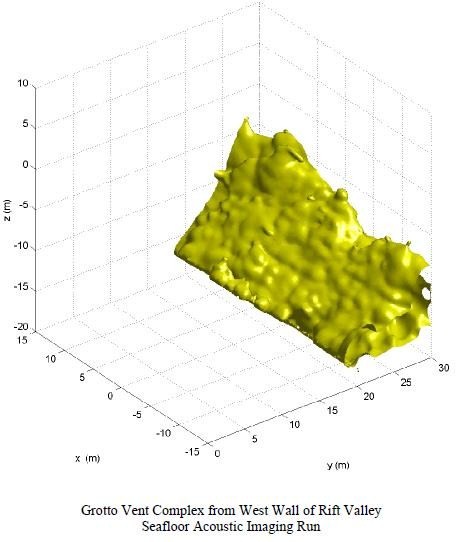VIP (Vent Imaging Pacific) 2000 Cruise Summary
The objective of the VIP (Vent Imaging Pacific) 2000 cruise (R/V Thompson Cruise 114; 21-31 July 2000 port-to-port Seattle) was to acoustically image hydrothermal flow regimes in the Main Endeavour Field centered at 47°56.0°N, 129°05.5°W on the Endeavour segment of the Juan de Fuca Ridge (Figure 1, track chart; Delaney et al., 1992). The acoustic imaging was done in coordination with in situ monitoring and measuring of these flow regimes by other cruises as part of the NSF RIDGE Program Observatory Experiments at that site. The purpose of the acoustic imaging is to determine the behavior of these flow regimes as the principal agents of dispersal of heat and chemicals from the lithosphere to the hydrosphere in quantities that impact the ocean environment, support chemosynthetic ecosystems, concentrate metallic mineral deposits, and play a role in dispersal of vent biota. The acoustic imaging and visualization of plumes discharging from black smoker-type vents and diffuse flow discharging from large areas of the seafloor in hydrothermal fields utilizes innovative new methods developed by the research partnership which carried out this cruise. The research partnership comprises the Institute of Marine and Coastal Sciences (Rutgers University), the Applied Physics Laboratory (University of Washington), the Japan Marine Science and Technology Center (JAMSTEC), and the Atlantic Oceanographic and Meteorological Laboratory (NOAA).
The plume imaging is based on acoustic volume backscatter from particulate matter suspended in the black smoker plumes (metallic mineral particles of the "black smoke"; Palmer et al., 1986; Rona et al., 1992). The imaging of diffuse flow is based on acoustic scintillation which senses this form of discharge by recording the distortion of an acoustic pulse by sound speed variations related to water temperature fluctuations as the pulse is reflected through a lens of warm water (Rona et al., 1996). The measurement of fluid flow rates is based on coherent Doppler measurements (Jackson et al., 2000).
We employed a modified state-of-the-art sonar system (Simrad SM 2000 system) for the acoustic imaging mounted on ROV Jason by the Deep Submergence Group of Woods Hole Oceanographic Institution. Modification comprised addition of a mechanical rotator and related
software to scan plumes. Cruise operations and Jason dive summaries are presented in this Cruise Report under, "Jason Operations". The acoustic imaging work was accomplished on two dives of ROV Jason, one dive of short (Dive JAS-282; 07/23/00; 17 hours) and one of long
duration (Dive JAS-283; 07/24-28/00; 112 hours). Dive JAS-283 established a new record for the duration of an ROV Jason deployment. A third dive was aborted (Dive JAS-284) to change a malfunctioning temperature sensor. The fourth and final dive (Dive JAS-285) was devoted to in
situ measurement of temperature and flow rate at selected black smoker-type vents and areas of diffuse flow, and moderate sampling of biota on active chimneys.
We performed 4 types of acoustic experiments on hydrothermal flow regimes in the Main Endeavour Field, as follows:
1) Panoramic imaging (range 10 to 150 m) of 4 vent clusters each tens of meters wide and high (Peanut-Puffer-Bastille group; Salut, S & M and Grotto sites): The panoramic imaging shows seafloor features, plumes (based on acoustic backscatter from suspended particulate matter), and diffuse flow (based on acoustic scintillation thermometry). The images reveal differences between the 4 vent clusters in intensity of venting and partitioning between black 2 smoker plumes and diffuse flow.
2) Time series of panoramic images: The time series (hourly during 24 hour period at Grotto vent site) shows the effect of a mixed semi-diurnal tide on intensely venting plumes and diffuse flow.
3) Flow rates: Flow rates were measured in black smoker plumes (Grotto vent site) using the coherent Doppler method.
4) Diffuse flow: Acoustic scintillation mapping of diffuse flow was conducted to test stationary and moving modes (multiple sites).
In addition to the acoustic experiments, we ran several high-resolution bathymetric lines to fill gaps in a bathymetric survey of the Main Endeavour Field initiated on a prior leg and recorded two CTD-transmissometer profiles in the study area.
Preliminary cruise results are scheduled for presentation at the Fall Annual Meeting of the American Geophysical Union, 15-19 December 2000 in San Francisco (Rona, et al., 2000; Jackson et al., 2000; Bemis et al., 2000).
The research team acknowledges with appreciation funding support from the National Science Foundation (Grant NSF OCE 98-18841 to IMCS/Rutgers and APL/UW), from JAMSTEC, and from AOML/NOAA. We thank the ROV Jason team of the Deep Submergence Group at the
Woods Hole Oceanographic Institution for outstanding performance at sea and the Marine Operations Group and the Captain and crew of the R/V Thompson of the University of Washington for their strong support.For more information on the cruise or a complete cruise report please click here: Expedition TN114
© RUTGERS, The State University of New Jersey. All rights reserved.

